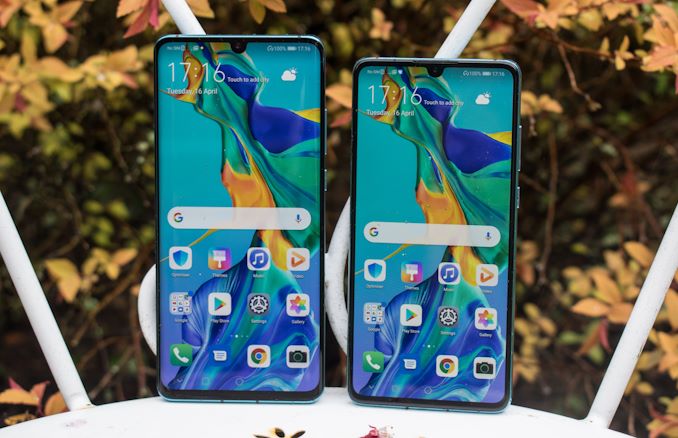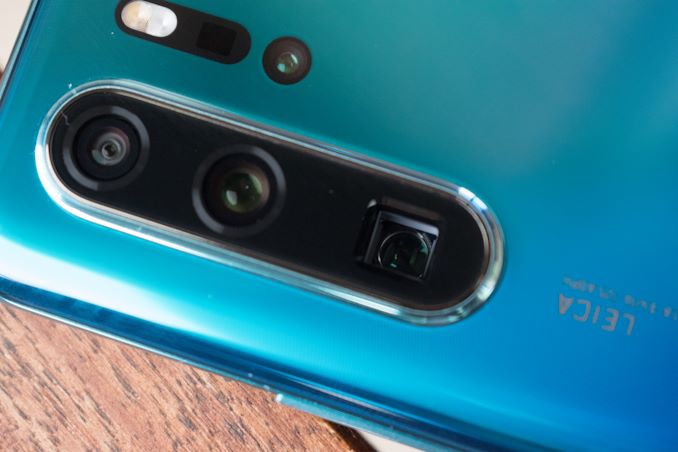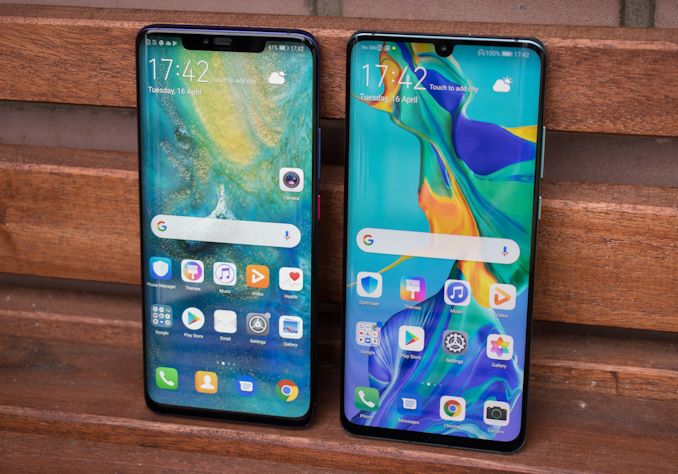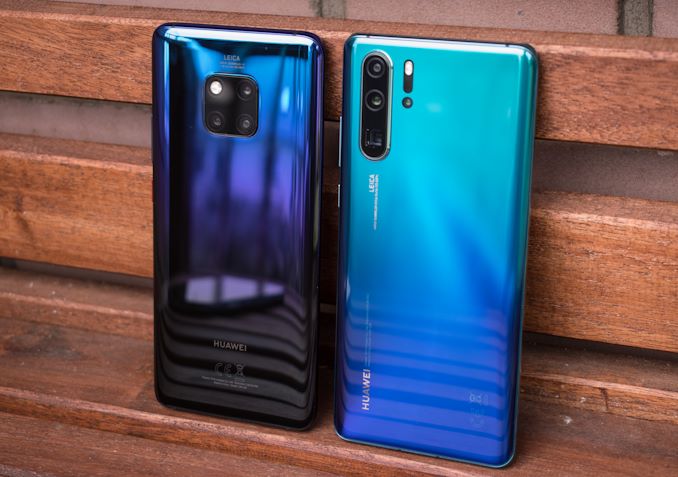The Huawei P30 & P30 Pro Reviews: Photography Enhanced
by Andrei Frumusanu on April 18, 2019 9:00 AM EST- Posted in
- Mobile
- Smartphones
- Huawei
- P30
- P30 Pro
Conclusion & End Remarks
In many ways, the P30 Pro and P30 are both iterative phones. Both devices are taking aspects first introduced in their predecessor P20 series – as well as the sister Mate 20 series – and improving and packaging them into phones with an emphasis on photography.
Design wise, the smaller P30 doesn’t differ all that much from the P20, keeping the same form-factor and also a similar design. Build quality has improved, and the device looks a more premium than its predecessor, mostly due to industrial design changes such the removal of the plastic rim between the body frame and the back glass panel.
Huawei’s choice to go with flat top and bottom frames is quite odd, and it gives the phones a more industrial look and feel than what we’ve become accustomed with compared to the more traditional rounded slab designs.
The bigger P30 Pro adopts the ergonomics of the Mate 20 Pro, meaning it has a curved and flowing display and back cover glass design. I find this design quite fantastic in terms of in-hand feel as well as ergonomics, and it makes the P30 Pro feel like much smaller phone than it actually is. One negative of the new ergonomics is the weight of the phone: at 192g the P30 Pro is a lot heavier than competing devices of its size.
The displays on both P30s are good. Particularly the move to an OLED augments the smaller P30 compared to its predecessor, the LCD-based P20. Huawei was able to seemingly avoid any display issues this time around, as opposed to the concerns of the LG panel units on the Mate 20 Pro. Colour calibration on both phones is good, albeit not excellent. Huawei has achieved better in past models, but it’s not a deal-breaker for the P30s. The only negative about the screens is that I really wish Huawei would have gone 1440p on the P30 Pro – there really is not technical excuse not to adopt it, and it’s just a matter of implementing it correctly.
The dew-drop display notches on the phones are minimal and not intrusive, and I find them better alternatives than what Samsung went with this year.
An odd difference between the two phones is that the P30 has an earpiece speaker while the bigger P30 Pro goes with a piezoelectric under-screen actuator. The problem here is that I just do not see the advantage of these new designs; the earpiece on the P30 is barely visible and sounds better. Unlike Samsung and LG’s recent models, neither of the P30s have stereo playback, and thus lag behind significantly in terms of speaker playback quality. To top off the audio concerns, Huawei continues the senseless design choice of skipping a headphone jack on larger and more expensive P30 Pro while including it on the smaller model..
Both phones have optical under-screen fingerprint sensors, and they’re excellent. The implementation is as good as OnePlus’s, and it’s a much faster sensor than Samsung’s ultrasonic units in the Galaxy S10 series.
The performance of the P30s is excellent thanks to the Kirin 980 SoC. We’ve covered this in past Kirin 980 devices and the new SoC is able to keep up with Qualcomm’s and Samsung’s best for this generation. GPU performance lags a bit behind the flagship competition, but it’s not too bad as it ties in with Snapdragon 845 devices.
Battery life for both phones is excellent, although no longer quite as class-leading, as this title remains with the Mate 20 as well as the new Galaxy S10+.
Cameras Differentiate the P30s
The main selling point of the P-series are supposed to be their cameras, and here Huawei did make some large and interesting changes.
First of all, both P30s now add the wide-angle sensors which were introduced in the Mate 20 series. The additions are fantastic to the shooting experience and Huawei is able to deliver very high quality results, with the P30 Pro having an advantage in quality due to its better sensor.
The zoom optics on the P30 remained the same as what we’ve found on the P20 Pro and Mate 20 Pro – it’s excellent and is able to achieve a higher optical zoom factor than competing devices. Due to the main sensor being 40MP, capturing digitally zoomed in/cropped shots at 2x factor while in 10MP results in little to no quality loss, with the 3x module picking up the slack for further away objects.
While the 5x telephoto module on the P30 Pro is technically impressive in just how far it’s able to go, I’m not very convinced that it’s actually all that beneficial to the everyday capture experience. In particular the device fails to properly bridge the gap between a ~2x and 5x zoom factor, where you’re left with deteriorating image quality and purely digital zooming on the main camera sensor. I honestly do not think that this is how most people use their phones, and I think the 3x zoom on the P30 and previous Huawei devices was a better alternative for the capture experience and most scenarios.
The main camera sensor on the P30s is also interesting. In daylight shots, there are some clear compromises in the new modules. The optics just aren’t as good as what's found on the Mate 20 Pro, and both units suffer from more chromatic aberrations on the outer edges of the images, something that’s immediately visible in the native 40MP capture modes. This issue affects the P30 Pro more than the P30 due to its wider aperture.
Also visible in daylight shots is that detail preservation isn’t as good as the Mate 20 Pro. Besides the optics, this might be caused by the new RYYB sensor which might not have as good pixel isolation as the previous generation sensor.
Daylight processing has changed when compared to the Mate 20 Pro, and while in most cases it’s better, in some cases it also saw regressions. The problem for Huawei is that there’s too large a difference in the processing and resulting images between the different modules. Again I feel as if Huawei putting the responsibility of achieving the best result to the user instead of delivering the best results out of the box. The phones are incredibly versatile in their cameras, but this is also their downfall as they lack consistency.
In low-light scenarios, the P30s are both absolute winners. The new sensor, and particularly the new optics with OIS on the P30 Pro, raise the bar yet again in terms of what one can expect out of a smartphone camera. Huawei’s real only competition here is Google’s Night Sight mode, however once it gets dark enough even the Pixel phones cannot compete with then new Huawei hardware. Compared to other vendors, it’s a completely different league.
Lastly, there’s the question of if the P30 phones are worth their money. Unfortunately I think Huawei’s yet again coming in a little too high on pricing. I have a hard time justifying the P30 Pro’s 999€ price point. The issue here is not only the competition, but also the question of whether this actually represents a better value than say the company’s own Mate 20 Pro, which can now be had for 699€. While impressive, I do not see the 5x telephoto lens as a selling point for the P30 Pro. This leaves the much better low-light capture as the only substantial benefit, as otherwise the P30 Pro represents a downgrade in speaker and display quality, with possibly slightly better battery life.
The P30’s 749€ price seems more reasonable, however again the Galaxy S10 is just 50€ more today, and you’re trading in the excellent low-light capture for an overall better phone.
I think both P30 phones are good devices, however it might be worth to wait a couple of months for the inevitable price drop, as the phones don’t tick all the boxes to be able to justify their launch MSRPs.














85 Comments
View All Comments
Quantumz0d - Thursday, April 18, 2019 - link
Good camera review, their auto mode looks good at night but the low light photography in smartphone arena is heavily faked. Be it Google insane algorithm for creating unnatural light or th damn Huawei night mode with HW. I think its too fake and perhaps they do have advantages in some situations but going from a dark room to a lit room is bad in my book.Next up the stupid curved glass copy they did from Samsung needs shaming. Plus its a waste that distortion of image is horrible and the damn construction is weak, see Jerry rig for it.
Then the worst parts - NanoSD ? WTF, please call them out for this, proprietary storages ? That's anti consumer, I use my SGS with 200GB SD card yes the 10Yr old phone with replaced battery and Fat32 works. And same in my iPods and V30S, and it works in PC without any stupid gimmicks or bloat.
Finally Andrei, I know your contribution to Samsung Exynos S9 disaster, it was only possible because it allows Bootloader unlock. That's the most powerful feature of Android and its principles of GNU GPL.
This Huawei junk is blocking access to that officially and in India I read the service centers demand DL for their Honor subsidiary, XDA portal people sold their soul to Huawei and OnePlus now their contract expired for OP and Huawei I guess. This is another massive hole in Huawei devices. I have every doubt about the firmware and SoCs from this CPC company I would really wish to have a Bootloader unlock for all their portfolio subsidiaries and themselves. Its bad, no ownership choice is horrible given how their EMUI blocks lot of stuff and notorious for its control over background processes.
You should include that in your reviews, please.
Thank you.
Quantumz0d - Thursday, April 18, 2019 - link
Also thank you for mentioning the 3.5mm jack and the stupid mono speaker in 2019. LG is Audio champion since a long time and hopefully they will retain that with their top class ESS Sabre implementation moving ahead. Also to note, LG and their new G8 has zero bumps which is a feat along with the Crystal Sound they call. Looking forward for piece.zeeBomb - Thursday, April 18, 2019 - link
You guys should take a look of MrWhoseTheBoss and his videos about this amazing phone. Such a shame you can't get it in carriers in the Americas, but man oh man.Ian Cutress - Thursday, April 18, 2019 - link
>You guys should take a look of MrWhoseTheBoss and his videos about this amazing phone.Any specific reason? You haven't exactly said why.
zeeBomb - Monday, May 6, 2019 - link
My bad. Sorry for the late reply too, he talks primarily about the sensor of the P30 Pro and its usefulness in Low Light. Just a suggestion to take a look.bogda - Thursday, April 18, 2019 - link
I think this statement: "...Huawei continues the senseless design choice of including a headphone jack on the smaller model while skipping it on the larger and more expensive P30 Pro.", makes much more sense if it is changed just a little bit into:"Huawei continues the senseless design choice of skipping a headphone jack on larger and more expensive P30 Pro while including it on the smaller model."
Awful - Thursday, April 18, 2019 - link
Great review but still missing half the picture when it comes to the camera. Time-of-flight sensor? Graduated blur based on depth map? Portrait/face lighting? People are the most photographed and most interesting subjects. Even if it's a mannequin with a wig for repeatability!s.yu - Friday, April 19, 2019 - link
Portrait lighting has been gimmicky for a few generations now. Regarding ToF, IIRC only the Nokia 9 has the proper implementation. Still there are pixel grade deviations and some people aren't satisfied. Personally if I were to add fake bokeh that precision would be enough for me.Awful - Saturday, April 20, 2019 - link
Yeah, they weren't really meant to be separate concerns- they're all factors contributing to portraits. I.e. how the exposure is chosen, how the depth is mapped to the bokeh/blue, how edge detection is done and masked for blurring, how AI/ML is used to make adjustments etc. All great computational photography stuff...that this review is silent on.Lau_Tech - Friday, April 19, 2019 - link
Hi Andrei, as a s10 exynos owner, was interested to see your updated comparison pics between the snapdragon and exynos. Looking at the pics from ur S10 review and now, it seems to me that the gap has closed substantially especially in daytime photos? What do you think?